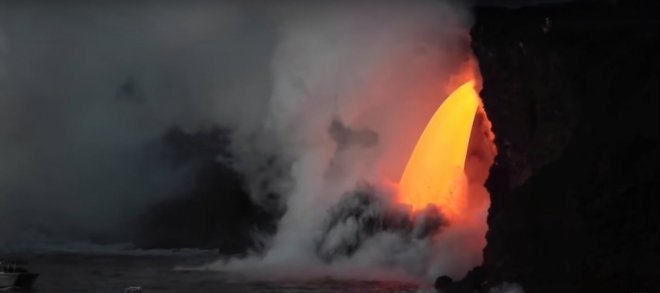
Stunning pictures of a "firehose" stream of molten lava have been captured by researchers USGS's Hawaiian Volcano Observatory. The eruption continues to hiss and burn after being splashed into the Pacific Ocean from a sea cliff on the island.
A "firehose" is a lava stream which shoots the molten materials outward from the source just like a hosepipe used in extinguishing fires. According to the Associated Press, the lava is from Kilauea, an active shield volcano which has been erupting continuously since 1983, and it is being poured into the Kamokuna ocean from a tube which got exposed after a 10.5-hectare lava delta collapsed into the sea on 31 December.
The lava started trickling down the cliff after the collapse but slowly started gathering intensity and is now arching out and falling about 70 feet to the ocean below. Moreover, massive explosions and huge waves were triggered after the newly-formed land collapsed.
Experts argue that this natural phenomenon can be extremely hazardous to human beings as massive littoral explosions are taking place every second. As soon as the hot lava is touching the water, the liquid is being converted to a gas with extreme speed, increasing dramatically in volume and in this process, large chunks of hot rock and debris are being thrown inland, where people hike in to see the lava. Debris is also getting thrown towards seaward, where tour boats often cruise.
Superintendent of Hawaii Volcanoes National Park, Cindy Orlando, also said that the Lava bench can collapse anytime and it would be catastrophic. To avoid any type of disaster, Orlando said that authorities have put up signs and cordoned off the area and declared strict action against people who will cross into prohibited areas. However, the superintendent said it is not possible to keep an eye on everyone.
USGS geologist Janet Babb also expressed concern about the possible collapse of the rock and said: "it's going to drop a lot of hot rock into the water" triggering massive explosive interactions.
"It's super-heated steam laced with hydrochloric acid from the interaction with the seawater and has shards of volcanic glass," she said, according to the news agency.
She also said that it is very unusual for a firehose event to last this long as lava tend to quickly solidify and build new land below which stop the flow. "In this case, there's no evidence of a new delta is forming, which leads us to believe that the offshore topography there is very steep," added Janet.
Check out the video here:








